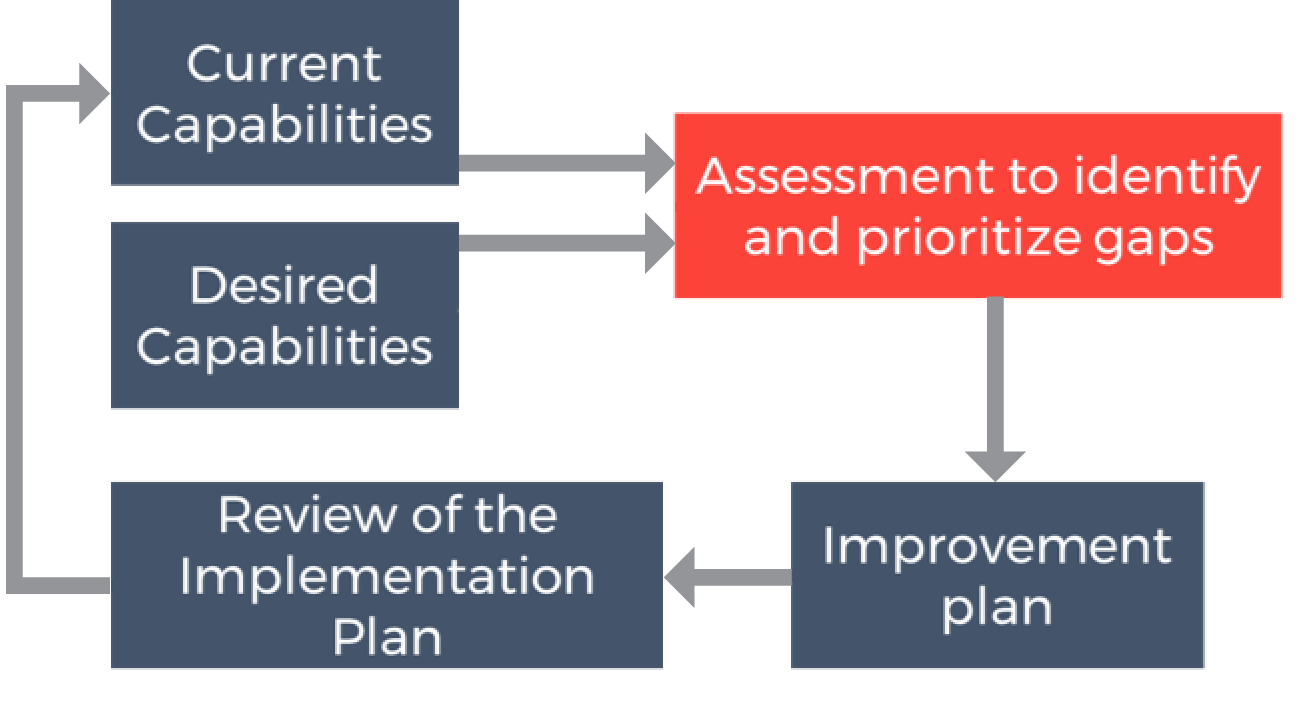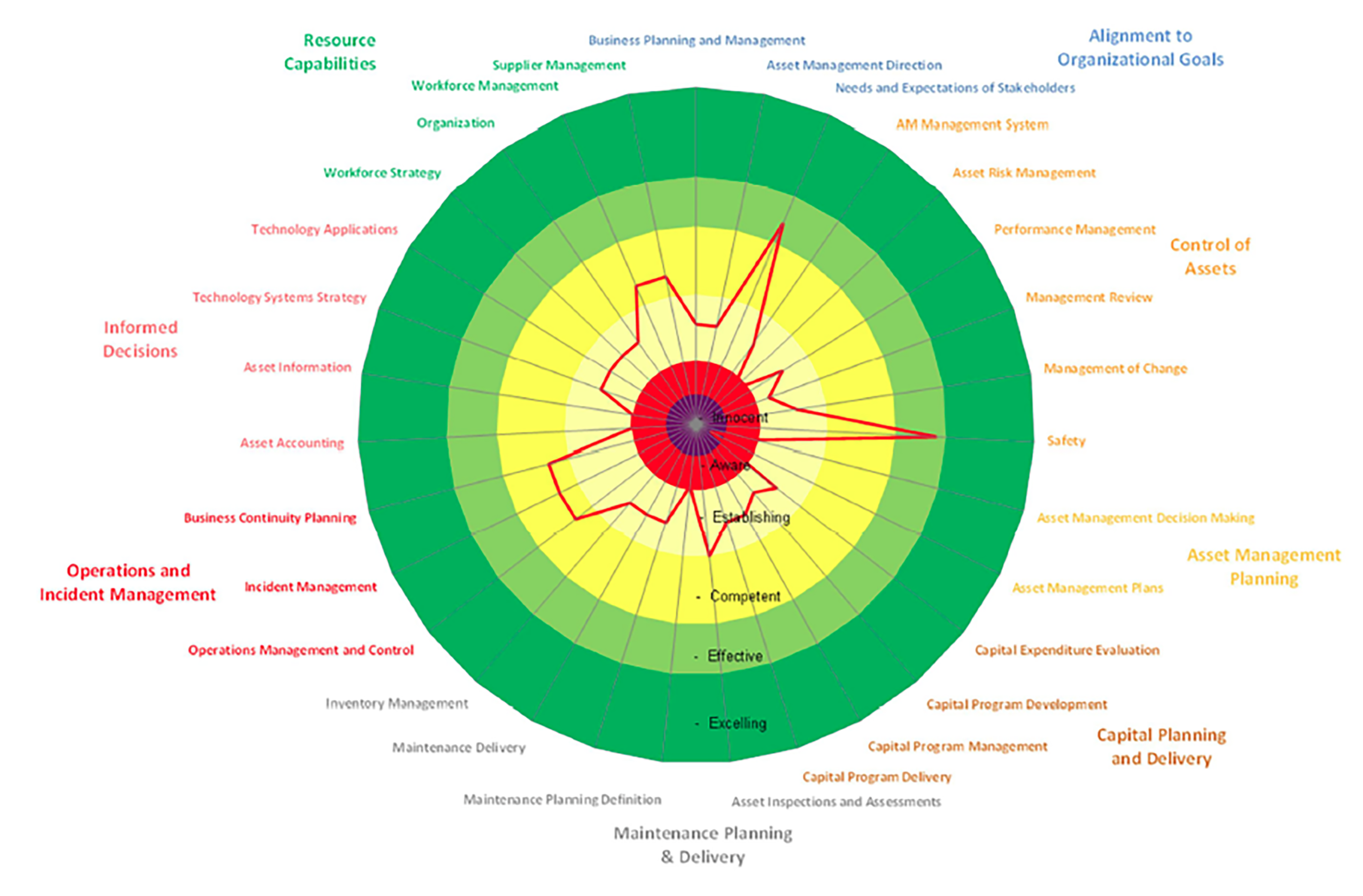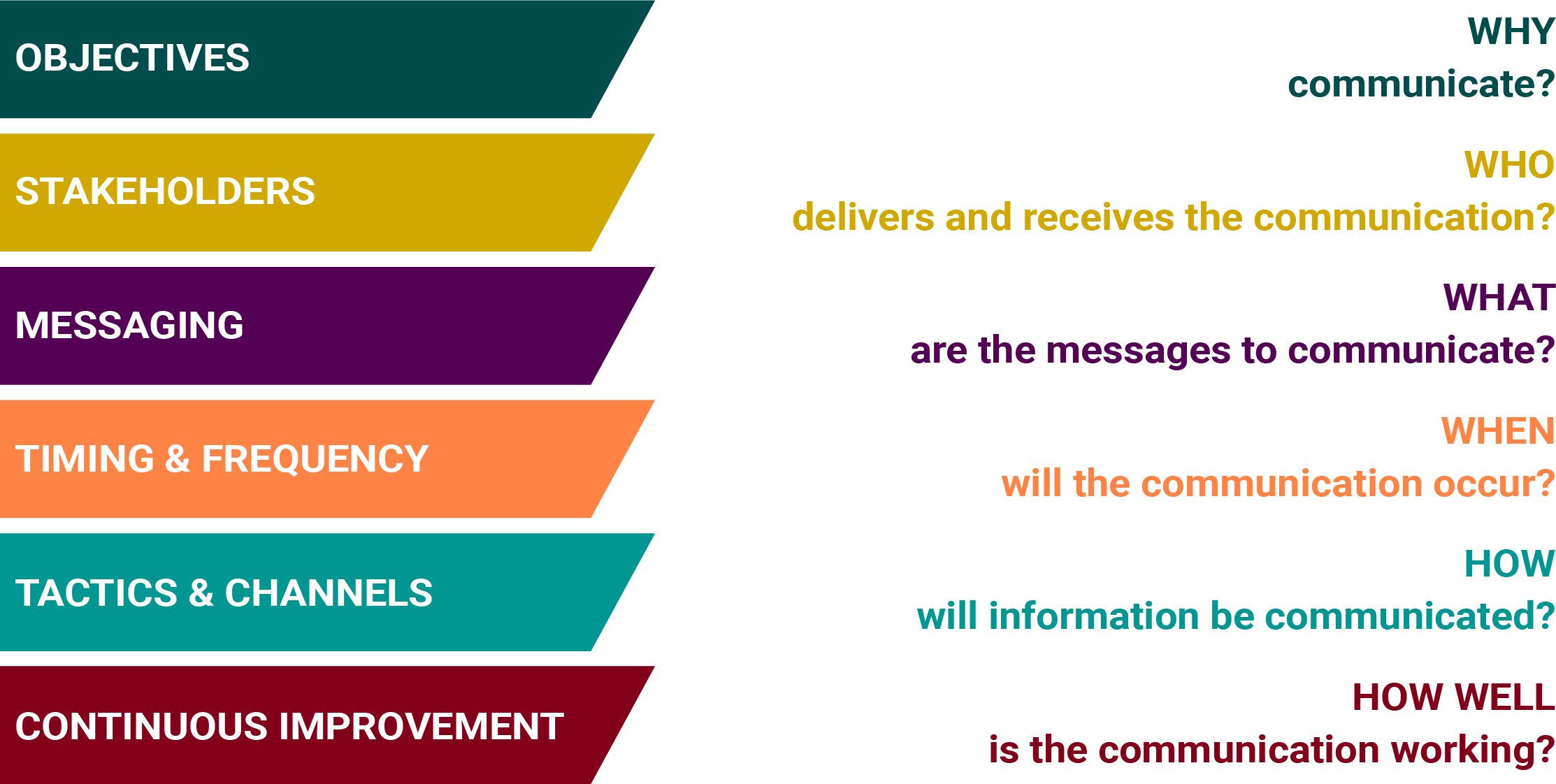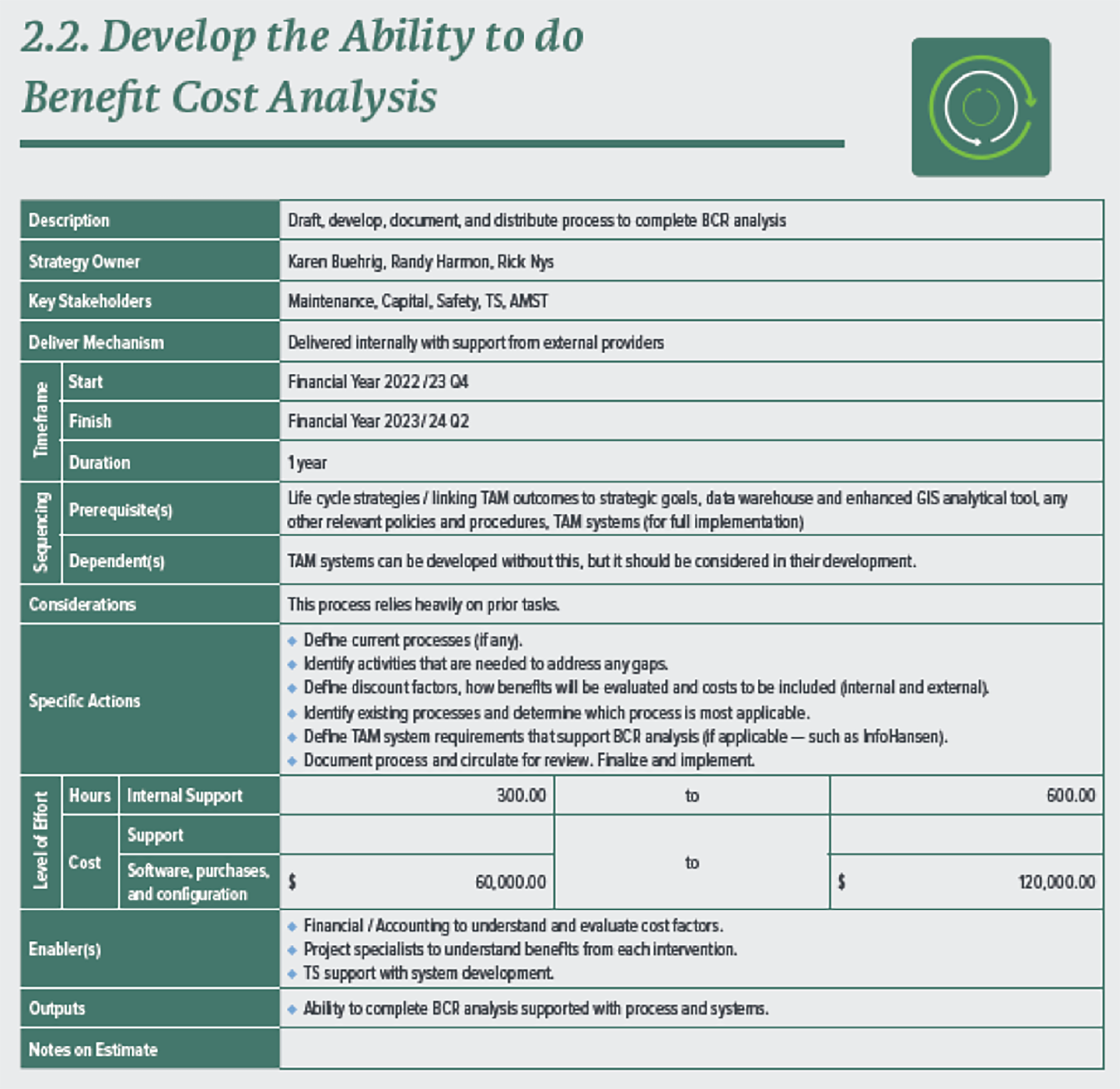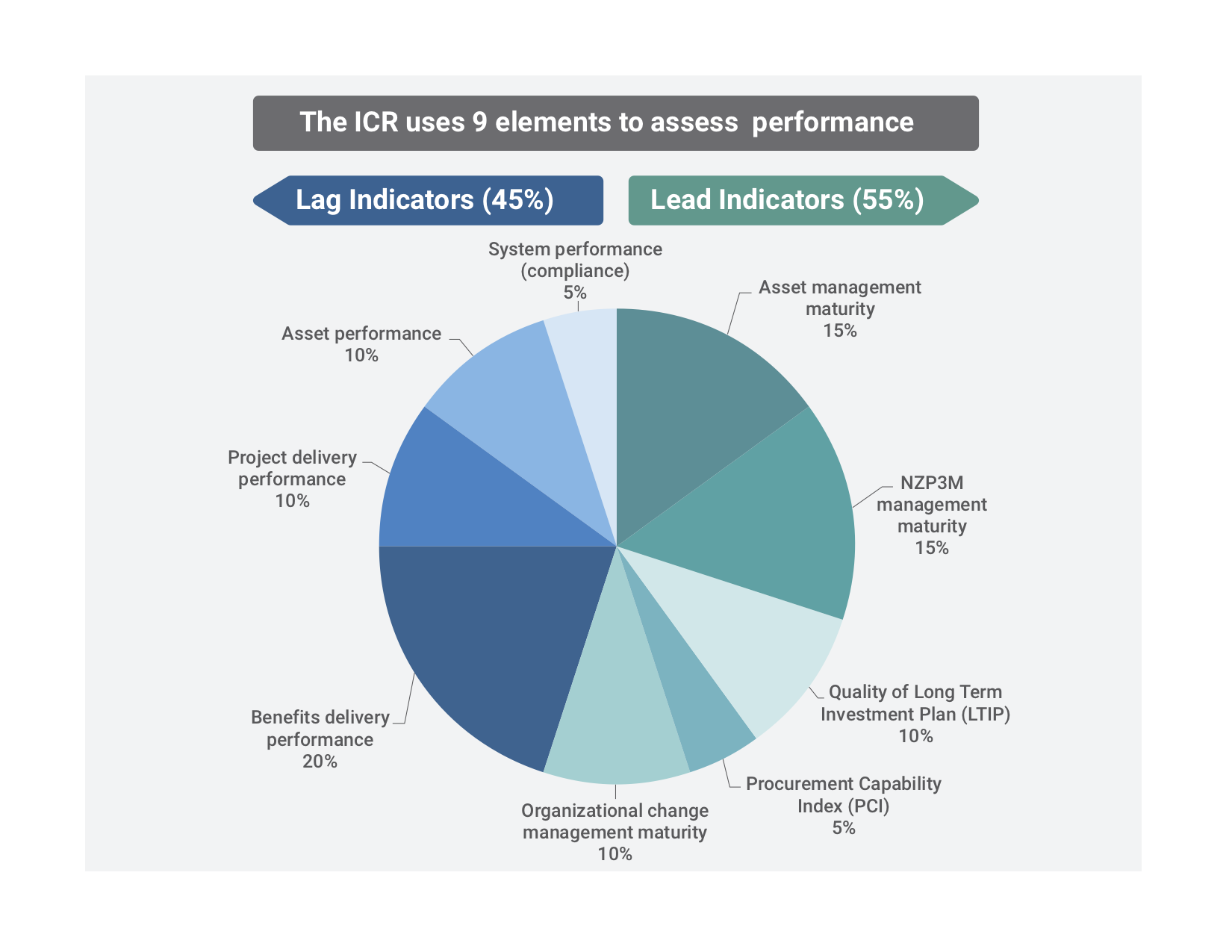- Chapters
-
Chapter 2
Sections - Chapter 2 Home Page
- Chapter PDF
Chapter 2
Quick Links
Section 2.3
TAM Assessment and Advancement
TAM Assessment and Advancement
Developing and implementing asset management can follow an incremental approach that helps shape processes over time. Asset management processes should be appropriate to the organization, the type of decision being made and the accuracy required in the decision-making process. Agencies may not always be ready for full-scale implementation of TAM, and incremental implementation can help make the best use of limited resources for managing assets while supporting management of the change introduced with improved asset management practice. A primary step in incremental asset management implementation is understanding the current strengths, weaknesses, achievable improvements and the areas where the most benefit can be gained.
- Chapters
-
Chapter 2
Sections - Chapter 2 Home Page
- Chapter PDF
Chapter 2
Quick Links
2.3.1
Assessing Current Practice
An assessment of current agency competency against industry-leading practice enables an agency to assess a desired future performance level. It can also help to identify the steps required to reach that goal.
TAM is an evolving process; ongoing improvement is an important component for a TAM program. In fact, the ISO 55001 Asset Management certification requires ongoing assessment and continual improvement.
A gap assessment process is used to understand how well an agency aligns with an established asset management framework. The gap assessment can be conducted internally or by a third party. Organizations seeking or wanting to maintain ISO certification will also undergo a formal third party audit.
The results of a gap assessment can help agencies identify changes in business processes needed to better link plans and decisions and better align to leading practice.
NCHRP Project 08-90 led to the development of a gap analysis tool, available through AASHTO and the TAM Portal. Figure 2.8 illustrates how this assessment tool is intended to be used. There are several other frameworks that can be used, including ISO 55001 and the Institute of Asset Management (IAM). A range of gap assessment framework’s are discussed further in Table 2.1. Each framework, process or tool will enable an agency to assess current performance and, from this, identify a desired capability level.
Figure 2.8 TAM Improvement Cycle
Source: Modified from original in NCHRP Project 08-90
TIP
Factors to consider when prioritizing advancement in TAM approaches will vary from agency to agency. Consider those factors that are of most importance to you and are well-aligned to your strategic goals.
In some cases, agencies also seek benchmarks that reflect how peers are performing to help them decide on the level of maturity and complexity to which they should aspire. ISO 55001 trends away from this. It encourages agencies to check against a framework of practices and process, and select what is best for the agency. Chapter 6 addresses benchmarking and related topics.
Actions to close gaps between desired and actual performance should be addressed within a TAM improvement or implementation plan.
Undertaking a gap assessment can form an important part of a change management process by aligning those within the agency on current performance, opportunities and targets for improvement.
Table 2.1 - Frameworks for Assessing Current Practice
| Framework | NCHRP 08-90 Gap Analysis Tool | ISO 55001 Asset Management Gap Analysis | International Infrastructure Manual (IIMM) | IAM Self-Assessment Methodology |
|---|---|---|---|---|
| Background | This tool was developed based on the tool and process created through development of the 2011 AASHTO TAM Guide. Uses a point scale for evaluating current and desired capabilities. See more | This is the most widely adopted standard for asset management globally. It is generic to accommodate many contexts. Describes a management system approach to asset management. See more | Recognizing that the ISO Standards for asset management are very much the “What to do”, the IIMM looks to provide the “How to do it”. Identifies an Asset Maturity Index (Aware, Basis, Core, Intermediate, Advanced) to identify the current and an appropriate level of asset management for each asset. See more | As an aid to the application of ISO 55001, the IAM decided to update their methodology into one that enables organizations in all sectors to measure their capabilities against the requirements of both PAS 55 and ISO 55001. See more |
| Assessment or Focus Areas |
|
|
|
|
| Why use this framework? | This framework is best for an agency that wants to work explicitly within a US-defined context that adopt wider influences. Since this tool can be fully customized by an agency, an agency that wants to tailor the analysis to their particular needs will find this useful. Finally, the tool facilitates the analysis of data, and can generate graphs and charts using the data imported into it. | This framework is ideal for agencies that want to adopt a world-recognized approach to asset management that provides a developed asset management lexicon. This is currently the most internationally-recognized standard in the world. | This framework has been refined over time with many examples that illustrate successful application of concepts by organizations. Public agency focused, and largely written for the asset management practitioner responsible for civil assets. | This standard is well recognized internationally, is infrastructure agnostic, and has applicability to infrastructure owners in both the private and public sector. It has many other resources developed along with the framework including training materials, reference guides and courses to upskill an agency. |
Amtrak
In 2016, Amtrak Engineering undertook an Asset Management Capability Assessment which bases maturity on the degree of formality and optimization of processes. The assessment uses several questions grouped into eight assessment areas, which describe operational processes necessary for asset management success. This maturity methodology is aligned with emerging guidance from the Institute of Asset Management (IAM), ISO 55001 standards, and requirements of the US FAST Act.
The assessment used a six-point scale, scoring Amtrak at the Establishing level, indicative of an agency that is actively developing asset management capabilities and establishing them to be consistent, repeatable, and well-defined.
Based on the 2016 assessment results, key challenges were identified and a series of improvement recommendations were developed and integrated into an Asset Management Improvement Roadmap.
In addition, Amtrak established a target position, driving process implementation priorities, with the intention of continuous monitoring by repeating the capabilities assessment process on an annual basis.
2016 Amtrak Asset Management Capabilities Assessment Results
Source: Amtrak Engineering 2019
- Chapters
-
Chapter 2
Sections - Chapter 2 Home Page
- Chapter PDF
Chapter 2
Quick Links
2.3.2
Defining and Prioritizing Improvement in TAM Approaches
Agencies managing different types of assets are faced with the decision of where to prioritize advancing formal asset management. Determining where to improve the organizations effort can depend on different factors, but should always align with the organizational context and priorities.
TAM Webinar #61 - TAM Innovations
For transportation agencies, asset management typically begins with the high-visibility, high-value assets, such as pavements and bridges. However, operating the transportation system requires a supporting cast of assets, typically referred to as ancillary assets, that include lighting structures, roadway signs, ITS assets or even operations facilities and technology hardware components. Establishing the appropriate management approach, and future desired approach for each asset is an essential step in strategic planning for asset management, defining boundaries around the effort. Furthermore, for each type of asset, it is important to determine how broadly to define the inventory of assets, such as the decision to include only arterial roads initially or all roads in a network.
Defining Appropriate Management Approaches for Different Asset Categories
An appropriate approach to manage and monitor each asset governed by the TAM framework needs to be established. Depending on the nature of the asset and the level of risk involved, different approaches can be selected by an agency.
Structuring asset management also involves evaluating different management approach- es and defining the appropriate level of maturity. There are several approaches to managing highway assets, each with different data needs, and several ways to structure and implement asset management processes. These include:
- Reactive-Based. Treatment is performed to fix a problem after it has occurred.
- Interval-Based. The asset is treated based on a time or usage basis whether it needs it or not.
- Condition-Based (Life Cycle Approach). Select intervention based on a forecasted condition exceedance interval.
Chapter 4 provides more details on these different approaches to managing assets.
Processes and approaches can range in their level of detail and complexity. This is what forms the foundation of some asset management maturity levels. Much like deciding on the scope of assets to manage, the level of advancement of the asset management processes an agency adopts should depend on the context and readiness of the agency, as well as the problem being addressed. Consideration should be given to the data, processes and tools available to support the asset management approaches and processes, as well as resource availability and capability. It is common for an agency to begin at a simple level and mature over time towards more complex asset management that integrates processes and decision-making.
Utah DOT
To accomplish the objective of allocating transportation funding toward the most valuable assets and those with the highest risk to system operation, UDOT developed a tiered system of asset management. Asset Management tiers range from one to three with tier one being the most extensive management plan for the highest value assets.
Tier 1. Performance-based management
- Accurate and sophisticated data collection
- Targets and measures set and tracked
- Predictive modeling and risk analysis
- Dedicated funding
Tier 2. Condition-based management
- Accurate data collection
- Condition targets
- Risk assessment primarily based on asset failure
Tier 3. Reactive management
- Risk assessment primarily based on asset failure
- General condition analysis
- Repair or replace when damaged
Source: Utah DOT. 2018. Utah TAMP. https://www.tamptemplate.org/tamp/053_utahdot/
Prioritizing TAM Improvements
Deciding on the appropriate management approach and level of asset management is a strategic decision that should consider several factors:
Organizational Strategic Goals
The decision of which assets to prioritize should be driven by the organization’s strategic goals. A desire to focus on one aspect of the transportation system over another in order to meet a larger objective can present a good reason for prioritizing some assets over others.
Asset Value
A common consideration for selecting assets to include is the financial value. Monetizing value provides a consistent way of comparing asset classes. In general, assets that are the most expensive to replace or cause the greatest financial concern for an organization fall into the highest priority. Strategic management of these assets means strategic investments over the life cycle of the asset, which will prevent or delay the need for significant additional investment, help avoid premature failure, and allow time to plan for appropriate replacement.
Data Availability
TAM as a concept is heavily dependent on data. Deciding on which assets to focus on based on existing data collection and management practices and will often support achievement of “quick wins.” Data availability does not always indicate strategic priority or risk exposure of the asset, but can still be an important factor in selecting assets to include the cost of collecting and analyzing data to form the basis for more advanced TAM decision making can in some instances be significant, and require new skills and training.
It should be recognized that data does not need to be comprehensive and complete as a basis for TAM decision making. An accepted approach is to group assets into classes (age, type, function) and then inspect a sample set. This can provide important insights to guide long-term planning at minimal initial expense/time. It can also highlight any issues with particular types of assets and allow for more detailed inspections to be undertaken if required. A gap analysis to define future data requirements and determine how to collect this data should be considered for long term TAM outcomes.
Risk of Failure
Often, it can be necessary to consider including assets if the probability and consequence of failure is significant. Assets with a high risk of failure can be a high priority due to the potential losses to the agency and its stakeholders should they fail. Asset management can alleviate or prevent the impact of failure.
Asset Criticality and Network Reliability
Decisions to formally manage certain assets can be based on their importance to the service provided, such as operations, or the importance of the travel paths under consideration. Defining criticality is context specific, but is important, since user experience is based on the journey, not the specific assets. Considering criticality in selecting assets to include in TAM will ensure that the most important assets–those necessary to maintain network reliability–are managed first.
Stakeholder Influence
In general, the scope of TAM should be agreed to in coordination with leadership and influenced by stakeholders. Stakeholders can be any asset owners, metropolitan planning organizations (MPOs), cities, tolling authorities, P3 concessions, federal (mandated requirements), and others. The public can also be stakeholders who influence which assets to include, especially when high-profile incidents potentially attributed to the state of good repair occur.
Aurizon
Aurizon is Australia’s largest freight rail operator, transporting more than 500 million tons of coal to markets including Japan, China, South Korea, India, and Taiwan, in addition to over 800 million tons of freight through an extensive network throughout the country. Aurizon Network manages the largest heavy haul rail infrastructure network in the country. The network is economically regulated by the State through a process that sets investment levels and tariffs. Asset management practice is well-entrenched in the organization, with a focus on “optimizing the life of assets, keeping a tension between investment in maintenance and capital.” The scope of the Aurizon Network asset base, known as the Regulated Asset Base includes all assets used in the provision of the rail infrastructure service. Management is informed by external engineering standards and legislative and regulatory obligations including:
- Prevention and intervention levels specified in an Asset Maintenance and Renewals Policy.
- Commitments to the Central Queensland Coal Network.
- A Safety Management System aimed to minimize safety risks.
- Network Strategic Asset Plan models which are based on asset age, predicted condition and historical and forecasted usage.
Source: Aurizon. 2019. Network: Planning and Development.https://www.aurizon.com.au/what-we-deliver/network#planning---development
- Chapters
-
Chapter 2
Sections - Chapter 2 Home Page
- Chapter PDF
Chapter 2
Quick Links
2.3.3
Developing a TAM Implementation Plan
A TAM implementation plan can clearly communicate an agency’s next steps for TAM and define responsibilities for implementation.
TAM Webinar #39 - TAMP Implementation
The product of a gap assessment will often take the form of an implementation plan for TAM improvements. These improvements can involve changing behaviors across many business units within an organization. The actions should, therefore, be prioritized and staged to advance one step at a time. When defining actions, it is important to understand the purpose and outcome to be achieved, who is responsible, how long it will take and how many resources are required for it to happen.
Note that a TAM Implementation Plan is different from a Transportation Asset Management Plan (TAMP) described further in Section 2.4. An implementation plan focuses on business process improvement, while a TAMP focuses on an organization’s assets and how it is investing in and managing them. However, the implementation plan may be included as a section of a larger TAMP.
The improvements identified need to recognize potential barriers to implementation. As an example, improving decision-making tools will likely require improvements in data practices. The implementation plan should consider any foreseeable obstacles, including staff resistance to new business procedures, lack of support from agency leadership, inadequate skills among staff, data integration issues or outdated analytical tools.
Communicating the Implementation Plan
Effective, organization-wide communication can serve as a powerful tool to facilitate smooth and swift adoption of the TAM implementation plan. At the start of implementation, communicating the future vision and benefits can help build awareness and buy-in. Throughout the duration of the implementation initiative, communication about milestones and accomplishments can help sustain or regain momentum. Additionally, as different projects are initiated, delivered and completed, agencies will want to ensure that the resulting changes in processes, systems and tools are adopted and used consistently to achieve the intended outcomes and objectives. As illustrated in Figure 2.9, the TAM communication strategy should cover six key elements – why, who, what, when, how and how well.
Objectives. Why communicate?
Establishing early buy-in to the implementation plan by providing an upfront explanation of why execution of the TAM implementation plan is needed—the anticipated benefits for the organization as well as for different stakeholder groups—will help jumpstart success of the implementation.
Stakeholders. Who delivers and receives the communication?
To make sure the right people are receiving the right information, it is key to develop and categorize a complete list of internal and external stakeholders who will be impacted by the TAM implementation plan and its resulting changes. In determining stakeholders, consider who needs to receive different types of information and who best to deliver that information to support achievement of implementation plan objectives.
Messages. What are the messages to communicate?
In developing the key messages to communicate, consider intent – what should stakeholders know, think or do as a result of the message? Key messages should promote awareness, desire and reinforcement of the implementation plan and its associated changes. They should also align with objectives of the implementation plan as well as organizational objectives.
Timing & Frequency. When will the communication occur?
Communication about the TAM implementation plan and corresponding changes should be timely, frequent enough to keep stakeholder groups well informed about approaching milestones and key dates of impact, and not so frequent that they lose value. Take into account what is being communicated and to whom, as different stakeholder groups receiving different types of messages often require different delivery frequency.
Tactics & Channels. How will information be communicated?
Depending on the duration of the TAM implementation plan and the number of associated changes, communication needs often shift over the course of its execution. Agencies should determine the most effective types of communication and delivery channels as they progress through change. By including stakeholder categories, messages and frequency as inputs when determining the most effective channels, the communications strategy remains agile, which facilitates continuous improvement.
Continuous Improvement. How well is the communications strategy working?
Assessing the effectiveness or performance of any strategy is important for achieving objectives. Including a stakeholder feedback loop into the communications strategy is one way to accomplish this. Agencies can use surveys, polls, focus groups or meetings to gather information and gauge opposition and support. This crucial feedback serves as guidance for subsequent content and can lead to changes in the communications strategy.
Figure 2.9 Communicating the Plan
Key questions to answer in communicating your implementation plan.
Clackamas County DOT
Based on their gap assessment, Clackamas County Department of Transportation and Development established a Transportation Asset Management Strategic Plan (TAMSP), which documents its methods to implementing a comprehensive transportation asset management program over a five year period. This TAMSP was accompanied by an asset management implementation strategy that identified the key actions to be undertaken.
Clackamas County, 2051 Kaen Road #426 Oregon City, OR 97045
Extract from Clackamas County DOT Implementation Plan
- Chapters
-
Chapter 2
Sections - Chapter 2 Home Page
- Chapter PDF
Chapter 2
Quick Links
2.3.4
Monitoring TAM Program Improvements
Measuring TAM improvement is important for understanding if the plan needs adjustment, and to communicate success and motivate those responsible for implementation.
Once a commitment to make improvements has been made, the improvement process needs to be managed and monitored.
Regular updates, meetings, performance tracking (monitoring improving performance against the selected framework) and scheduled reviews by the TAM Governance Groups will help provide oversight to those responsible for undertaking the improvements.
This process also helps remove roadblocks by involving leaders from across the organization.
When to Re-Assess Performance
A regular commitment to monitor progress is important. This assessment will compare progress from the initial benchmark toward the desired level of competency. There is no set recommendation for when to assess progress; some agencies find it more important in the early stages of implementation, while others do not.
When considering the timing of progress assessments, it is important to consider:
- Process checkpoints. The frequency could be aligned with reporting requirements, but should also consider appropriate points where progress will be noticeable.
- Commitment. Undertaking an assessment will take time and resources, so it is important this is balanced against progressing with implementation.
- Champions and change agents. As these individuals are critical to the overall success of TAM implementation, if they change or need to monitor their own performance, then a review of progress can help motivate and reset goals.
Measuring Performance Improvements
Monitoring performance of the asset management system and the results of improvement actions can be challenging, as the cost of service delivery, quality of service levels and risk of service failures may shift over time, and can change following the implementation of an improvement action. The IIMM suggests some of the following potential TAM system performance indicators:
- Financial performance
- Data management performance
- Timeliness relative to target response times
- Productivity and utilization of resources
- Skills availability relative to planned requirements
- Adherence to quality procedures
Chapter 6 provides more information on performance measures, targets, and monitoring asset performance. Self assessment can focus both on service / asset outcomes experienced by users, as well as be internally focused to determine how well the agency is aligned with desired practices. It is important that agencies consider and select the appropriate level and focus of self-assessment for their requirements.
TIP
TAM Maturity Assessments should end with an Improvement Program, highlighting areas for self-improvement, which can then be prioritized according to agency priorities or strategic direction.
New Zealand Transport Agency
The New Zealand Treasury stewards the NZ government’s Investment Management System to optimize value from new and existing investments and assets for current and future generations of New Zealanders. One of the tools the system uses is the Investor Confidence Rating (ICR), which illustrates the confidence that government leadership (i.e. Ministers) can have in an agency’s ability to deliver investments that produce the desired results.
The ICR also promotes and provides a pathway for capability uplift. One element of the ICR evaluates the gap between current and target asset management maturity levels on the basis that good asset management practice provides the foundation for good investment management. The Treasury recommends periodic self-assessments using a methodology based on international asset management guidelines and the ISO 55001 standard.
The ICR assessment is conducted every 3 years, resulting in more decision-making autonomy for agencies that obtain a good rating and potential flexibility over investment assurance arrangement.
Adapted from New Zealand Treasury. Investor Confidence Rating (ICR).
https://treasury.govt.nz/information-and-services/state-sector-leadership/investment-management/review-investment-reviews/investor-confidence-rating-icr
Amtrak
In 2016, Amtrak Engineering undertook an Asset Management Capability Assessment which bases maturity on the degree of formality and optimization of processes. The assessment uses several questions grouped into eight assessment areas, which describe operational processes necessary for asset management success. This maturity methodology is aligned with emerging guidance from the Institute of Asset Management (IAM), ISO 55001 standards, and requirements of the US FAST Act.
The assessment used a six-point scale, scoring Amtrak at the Establishing level, indicative of an agency that is actively developing asset management capabilities and establishing them to be consistent, repeatable, and well-defined.
Based on the 2016 assessment results, key challenges were identified and a series of improvement recommendations were developed and integrated into an Asset Management Improvement Roadmap.
In addition, Amtrak established a target position, driving process implementation priorities, with the intention of continuous monitoring by repeating the capabilities assessment process on an annual basis.
2016 Amtrak Asset Management Capabilities Assessment Results
Source: Amtrak Engineering 2019
Utah DOT
To accomplish the objective of allocating transportation funding toward the most valuable assets and those with the highest risk to system operation, UDOT developed a tiered system of asset management. Asset Management tiers range from one to three with tier one being the most extensive management plan for the highest value assets.
Tier 1. Performance-based management
- Accurate and sophisticated data collection
- Targets and measures set and tracked
- Predictive modeling and risk analysis
- Dedicated funding
Tier 2. Condition-based management
- Accurate data collection
- Condition targets
- Risk assessment primarily based on asset failure
Tier 3. Reactive management
- Risk assessment primarily based on asset failure
- General condition analysis
- Repair or replace when damaged
Source: Utah DOT. 2018. Utah TAMP. https://www.tamptemplate.org/tamp/053_utahdot/
Aurizon
Aurizon is Australia’s largest freight rail operator, transporting more than 500 million tons of coal to markets including Japan, China, South Korea, India, and Taiwan, in addition to over 800 million tons of freight through an extensive network throughout the country. Aurizon Network manages the largest heavy haul rail infrastructure network in the country. The network is economically regulated by the State through a process that sets investment levels and tariffs. Asset management practice is well-entrenched in the organization, with a focus on “optimizing the life of assets, keeping a tension between investment in maintenance and capital.” The scope of the Aurizon Network asset base, known as the Regulated Asset Base includes all assets used in the provision of the rail infrastructure service. Management is informed by external engineering standards and legislative and regulatory obligations including:
- Prevention and intervention levels specified in an Asset Maintenance and Renewals Policy.
- Commitments to the Central Queensland Coal Network.
- A Safety Management System aimed to minimize safety risks.
- Network Strategic Asset Plan models which are based on asset age, predicted condition and historical and forecasted usage.
Source: Aurizon. 2019. Network: Planning and Development.https://www.aurizon.com.au/what-we-deliver/network#planning---development
Clackamas County DOT
Based on their gap assessment, Clackamas County Department of Transportation and Development established a Transportation Asset Management Strategic Plan (TAMSP), which documents its methods to implementing a comprehensive transportation asset management program over a five year period. This TAMSP was accompanied by an asset management implementation strategy that identified the key actions to be undertaken.
Clackamas County, 2051 Kaen Road #426 Oregon City, OR 97045
Extract from Clackamas County DOT Implementation Plan
New Zealand Transport Agency
The New Zealand Treasury stewards the NZ government’s Investment Management System to optimize value from new and existing investments and assets for current and future generations of New Zealanders. One of the tools the system uses is the Investor Confidence Rating (ICR), which illustrates the confidence that government leadership (i.e. Ministers) can have in an agency’s ability to deliver investments that produce the desired results.
The ICR also promotes and provides a pathway for capability uplift. One element of the ICR evaluates the gap between current and target asset management maturity levels on the basis that good asset management practice provides the foundation for good investment management. The Treasury recommends periodic self-assessments using a methodology based on international asset management guidelines and the ISO 55001 standard.
The ICR assessment is conducted every 3 years, resulting in more decision-making autonomy for agencies that obtain a good rating and potential flexibility over investment assurance arrangement.
Adapted from New Zealand Treasury. Investor Confidence Rating (ICR).
https://treasury.govt.nz/information-and-services/state-sector-leadership/investment-management/review-investment-reviews/investor-confidence-rating-icr

